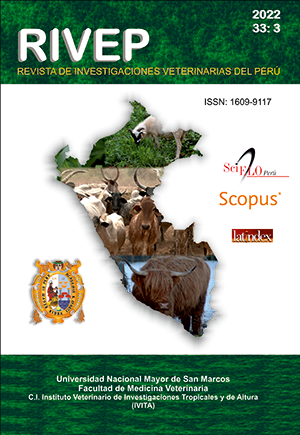Mammary echography in ewes as a tool to evaluate udder abnormalities and its relationship with performance of their progeny
DOI:
https://doi.org/10.15381/rivep.v33i3.21301Keywords:
ultrasonography, images, growth, lambsAbstract
The ultrasound structure of the udder in sheep was evaluated as a tool for monitoring mammary health and its relationship with the productive performance of the progeny. Twenty-two females and their respective offspring were randomly selected. An ultrasound evaluation and the Image J® 1480 program were performed for image analysis. In the udders, the type of tissue, consistency and presence of abscesses were measured. Body condition score, age and breed type were recorded in the dams, and birth weight, weaning weight and daily weight gain were recorded in lambs. The information was evaluated through analysis of variance, correlation analysis and multiple regression. A significative effect was found in the number of pixels per ultrasound slice (p<0.05), with the highest number of pixels in parenchyma and soft tissue. Effect of age and breed type on the number of pixels was observed. The lowest number of pixels was observed in abscesses and cistern tissue compared to parenchyma (p<0.05). A significative effect of body condition was found when udder consistency, age and breed type was considered (p<0.05). All study variables were significant in the regression model (p<0.05), where the variables that explain the greatest variability are type of tissue and body weight gain. The number of pixels tends to increase in healthy udders. It is concluded that ultrasound in sheep can be used as an indicator of mammary health with a strong relationship with daily weight gain of the lambs.
Downloads
Downloads
Published
Issue
Section
License
Copyright (c) 2022 Gabriela Castillo-Hernández, Omar Salvador-Flores, Jorge Alonso Maldonado-Jáquez

This work is licensed under a Creative Commons Attribution 4.0 International License.
AUTHORS RETAIN THEIR RIGHTS:
a. Authors retain their trade mark rights and patent, and also on any process or procedure described in the article.
b. Authors retain their right to share, copy, distribute, perform and publicly communicate their article (eg, to place their article in an institutional repository or publish it in a book), with an acknowledgment of its initial publication in the Revista de Investigaciones Veterinarias del Perú (RIVEP).
c. Authors retain theirs right to make a subsequent publication of their work, to use the article or any part thereof (eg a compilation of his papers, lecture notes, thesis, or a book), always indicating the source of publication (the originator of the work, journal, volume, number and date).



